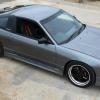Thread For My Car Problems.
Announcements
-
Similar Content
-
Latest Posts
-
Fire up the 3D printer and break out the silver paint.
-
That'd be right ~ the early RE5R01A is pretty much the same as the RE4R01A in many ways ; problem is they made lots more 4-speeds than 5-speeds.... I'm in AU, so you'll need apply the US supply scene... https://www.alltranz.com.au/shop/drivetrain/automatic-transmission/Mazda/RE5R01A/#scroll-electrical_components This'll give you the aftermarket parts listings -- you're looking for #56712 & #56713
-
Haven't received that part yet, but seeing as you mentioned it I do have some aluminium foil somewhere.... it'll be good for a laugh
-
At a guess being carb all the dash loom will be different & will probably need more work there or replaced.
-
By robbo_rb180 · Posted
yes easily doable was very common conversion around 15+ years ago Require: Sr20 cross member and engine mounts sr20 gearbox or bell housing if manual CA already sr20 loom and ecu sr20 radiator (or make a cross over pipe to us CA style radiator) sr20 engine All parts can be sourced from an s13 Will require some mods to engine loom to body loom plugs but plenty of info out there on that.
-







Recommended Posts
Create an account or sign in to comment
You need to be a member in order to leave a comment
Create an account
Sign up for a new account in our community. It's easy!
Register a new accountSign in
Already have an account? Sign in here.
Sign In Now